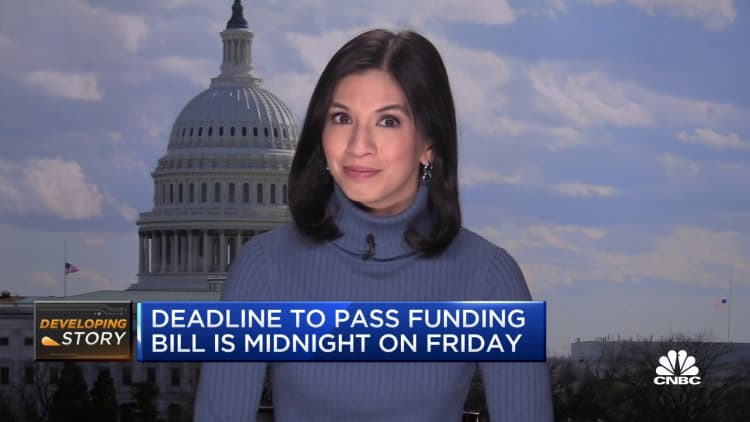
Sporrer/Rupp | Image Source | Getty Images
Participation in workplace retirement plans may soon be expanded, thanks to new efforts from lawmakers on Capitol Hill.
A group of retirement provisions, dubbed “Secure 2.0,” have been included in the government spending bill for the 2023 fiscal year.
But as Congress rushes to push the changes through before the end of the year, the legislation still falls short of addressing the crux of the retirement savings gap in the United States — the lack of access to retirement savings plans, according to researchers at the Schwartz Center for Economic Policy Analysis at The New School.
Secure 2.0 would require certain employers with retirement plans to automatically enroll eligible workers in those plans. That proposal would apply to new 401(k) and 403(b) plans starting in 2025. Certain businesses — those with 10 or fewer employees, those that have been open for less than three years, and church and government plans — would be exempt.
Yet the proposal still leaves a “huge problem untouched,” since employers can still decide whether to offer a retirement plan, said Teresa Ghilarducci, a labor economist and professor of economics and policy analysis at The New School. When they do provide plans, their designs are subject to little regulation, she said.

The proposed automatic enrollment expansions may have very little effect, according to Ghilarducci, because they do not include mandates for employer contributions or for employers to provide plans.
“The big part of the problem is that low-income people need help contributing and half of the people don’t have an employer that has a plan,” Ghilarducci said.
“And Secure 2.0 doesn’t do anything about those two major problems,” she said.
Low-income workers lack access to retirement plans
The statistics around retirement preparedness are grim for certain populations.
In a speech in Washington, D.C., earlier this month U.S. Secretary of Labor Marty Walsh noted just 36% of Black households ages 55 to 64 have any retirement savings. That number goes down to 30% for Hispanic households. Those who do have savings often have very little set aside, he said.
“This is a crisis that we have to address in the United States of America,” Walsh said.
A Bipartisan Policy Center-Morning Consult poll from earlier this year found just 52% of individuals with $50,000 or less in household income have access to an employer-sponsored retirement plan compared with 79% of people with higher household incomes.
More from Personal Finance:
‘This is a crisis.’ Why more workers need access to retirement savings
Not having an emergency fund can lead to this big money mistake
Why long Covid may be ‘the next public health disaster’
The “flawed system” has led the typical older worker earning less than $40,000 a year to have nothing saved for retirement, according to The New School’s research.
Older workers earning between $40,000 and $115,000 per year have a median $60,000 in savings. Meanwhile, workers earning over $115,000 have median savings of $200,000.
Up to 40% of middle-income workers are at risk of moving into poverty or near poverty in retirement, according to The New School’s research.
Between 2019 and 2045, the number of people over 62 who are in or near poverty will increase 22.3%, the report projects, from 18 million to 21.3 million.
Four key policy changes could prevent that, according to Ghilarducci.
The proposals are inspired by the recent introduction of the Retirement Savings for Americans Act. The bill was proposed in early December by Sens. John Hickenlooper, D-Colo., and Thom Tillis, R-N.C., and Reps. Terri Sewell, D-Ala., and Lloyd Smucker, R-Penn.
1. Create a universal retirement plan
For starters, we should abandon the hope that employers will cover everyone with retirement plans, according to Ghilarducci. Instead, creating a universal retirement plan may better accomplish that goal.
“A universal access plan is one in which everyone, regardless of what their employer does, is in a retirement plan,” Ghilarducci said.
The idea is included in the Retirement Savings for Americans Act, which would establish portable tax-advantaged retirement savings accounts for workers. Full- and part-time workers who do not already have access to retirement plans would be automatically enrolled in the program.
Importantly, the universal retirement plan would take out the voluntary component, Ghilarducci said. Contributions would happen with every paycheck. Moreover, just like you cannot borrow against your Social Security benefits, you mostly would not be able to access these funds until retirement.
For low-income workers who earn less than the median income, the government would also contribute to their retirement plans alongside the workers.
The retirement accounts would include a menu of low-fee investments that savers could choose from.
2. Make tax expenditures more equitable
A refundable federal tax credit could be made available to eligible low- to moderate-income individuals. This would be available even to people who do not have a substantial amount of money or do not file a federal tax return, Ghilarducci said.
The Retirement Savings for Americans Act calls for a refundable tax credit with up to 4% in matching contributions for low- to moderate-income workers. The credit would begin to phase out at median income.
This change would make the retirement system more equitable by ensuring the $250 billion already spent to help people save would include the bottom half of the income distribution. Currently, 70% goes to the top 20%, while less than 5% goes to the bottom half, Ghilarducci said.
The Secure 2.0 proposal would make this worse by loosening restrictions on people who own substantial individual retirement accounts, she said. The bill would raise the age when retirees must take required minimum distributions from 72 to 75, a change that would be phased in over 10 years.
3. Protect retirement savings
Early withdrawals from retirement accounts can undermine retirement security, particularly for low-income workers. Creating safeguards to prevent those distributions can help ensure the money is still there when an individual reaches retirement, according to The New School research.
Retirement assets should also not be counted when determining an individual’s eligibility for public assistance benefits, the research said.
Notably, the Retirement Savings for Americans Act aims to make it easier for workers to keep the retirement accounts set up through the new program by making it so they can keep them throughout their lives and stop and start their contributions at any time. It would also be possible to pass the money in the accounts down to future generations.
4. Strengthen and expand Social Security
Social Security helps guarantee people will not fall into poverty, no matter what happens to them.
As enhancements including universal retirement plans and private savings are put into effect, Social Security should also be strengthened and expanded, Ghilarducci said.
Benefits are a major source of income for the bottom half of the income distribution, and that money brings those beneficiaries up more than those in higher income tiers.
“It brings us actually a little closer together; it creates a community,” Ghilarducci said.
The Retirement Savings for Americans Act does not include Social Security reform. However, other legislative proposals have called for expanding the program.






